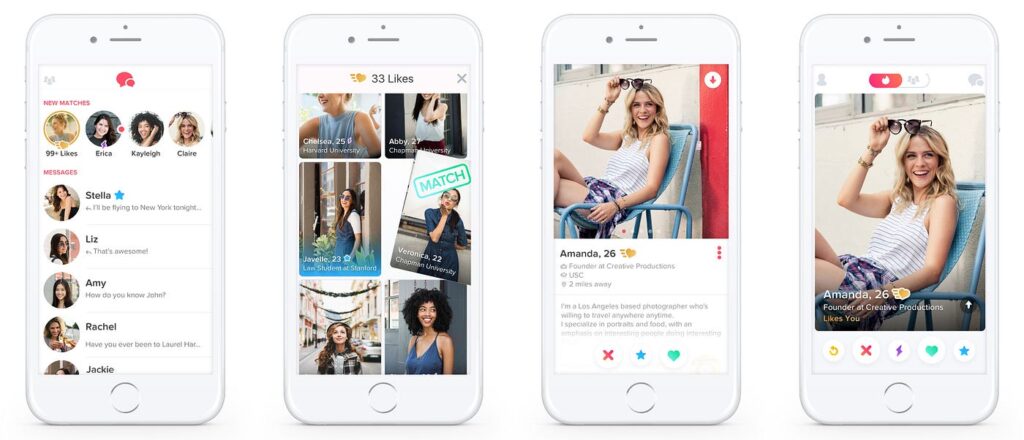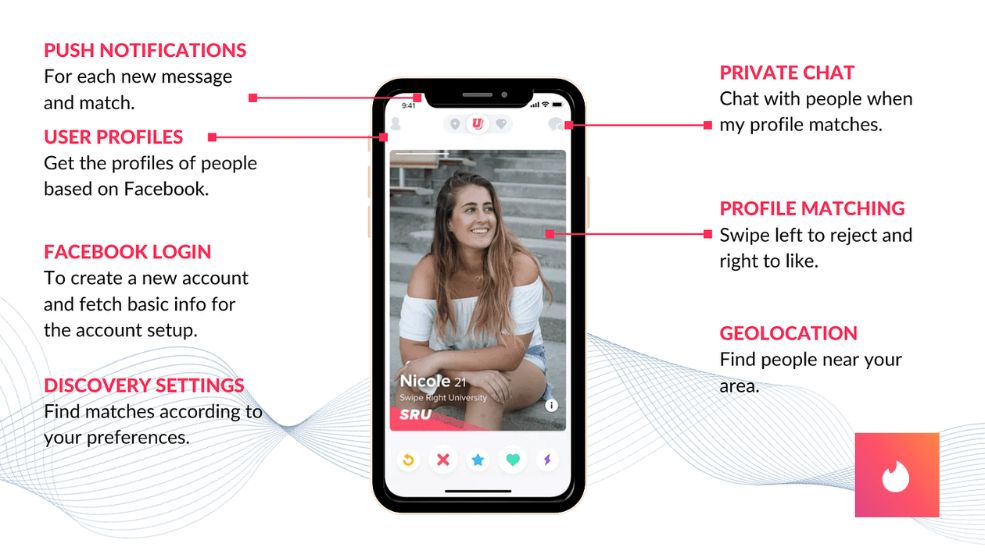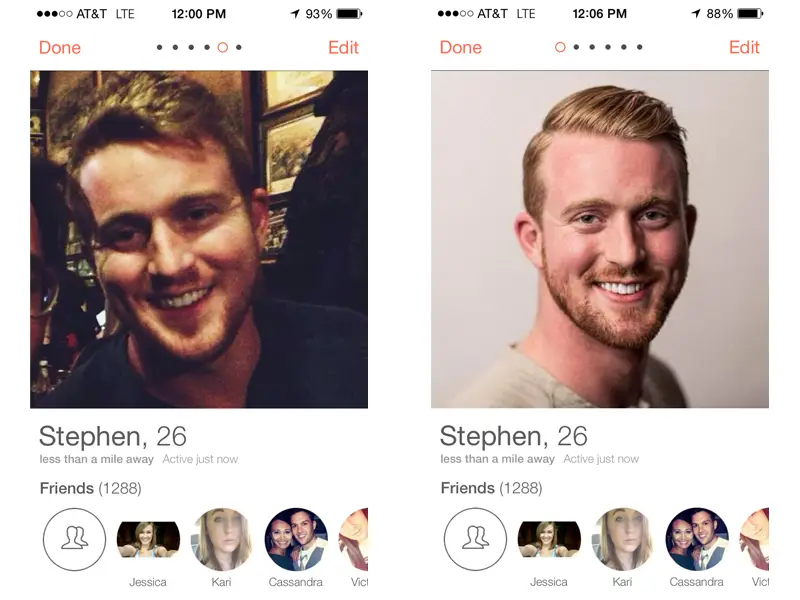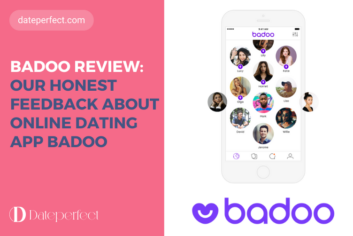Tinder, a prevalent online dating app available in both website and app formats, was launched on 09.12.2012. Catering primarily to a younger audience seeking casual relationships and hookups, Tinder boasts a massive global reach across numerous countries, with a user base size of millions. The platform’s website functionality includes a unique swipe-based interface, location-based matchmaking, in-app messaging, and integration with other social media platforms. Tinder’s core values center around user choice, simplicity in dating, and fostering online connections.
Information
| Website | tinder.com |
|---|---|
| Girls Online are Over | 2.2K |
| Mobile Friendly | Yes |
| Support | Friendly 24/7 Support |
- User-Friendly Interface: Tinder’s intuitive swipe feature revolutionizes ease of use, making profile navigation and decision-making quick and straightforward.
- Large User Base: With millions of users, Tinder offers a vast pool of potential matches, increasing the likelihood of finding compatible partners.
- Location-Based Matches: Geolocation technology ensures users find matches within their vicinity, facilitating real-world connections.
- Rapid Matchmaking Process: The app's design encourages fast-paced interaction, catering to those seeking immediate engagement.
- Social Integration: Integration with social platforms like Instagram provides a more comprehensive view of potential matches.
- Superficial Selection Process: The swipe mechanism often promotes decisions based on physical appearance, overshadowing deeper compatibility aspects.
- Limited Profile Information: Profiles on Tinder tend to offer minimal information, potentially leading to less informed match choices.
- In-App Purchases: Essential features like unlimited swipes and profile boosts require subscription or payment, which may limit the free user experience.
The User Experience on Tinder
Exploring Tinder’s user experience reveals a blend of simplicity and efficiency, making it a popular choice for those seeking casual connections. My personal interactions with the app, while generally positive, highlight some areas for improvement.
Sign-up Process and Creating a User Profile on Tinder
The sign-up process on Tinder is straightforward and user-friendly. Here’s a five-step guide based on my experience:
- Download the app and select ‘Create Account’.
- Verify your phone number or connect a social media account.
- Enter personal details like name, age, and gender.
- Add photos and a bio to personalize your profile.
- Adjust settings for distance and age range for matches. Tinder offers basic privacy settings, allowing some control over who sees your profile.

Tinder’s Design, User Interface and Usability
Tinder’s app layout is sleek and modern, with an appealing color scheme that invites users in. The navigation is intuitive, making it easy to swipe, find settings, and access messages. The user interface is clear and responsive, though I found the text and options could be more accessible for a broader range of users.
Tinder’s Mobile App Experience
Comparing Tinder’s mobile app with its desktop version, the mobile experience is more seamless and convenient, aligning with the app’s purpose of spontaneous connections. The app performs well across different devices, with minimal load times and rare crashes. However, the app’s reliance on network connectivity can be a limiting factor in areas with poor internet service.
Tinder’s Unique Features, Functionality and Matchings Algorithms
Tinder, with its blend of innovative features and matchmaking capabilities, has been a go-to app for casual connections, yet my experience has been a mixed bag. The app’s Geolocation-based connections and Swipe pattern analysis stand out, allowing me to connect with people nearby and indicating mutual interest with a simple swipe. However, the Matching algorithm accuracy, while decent in aligning with User preferences integration, sometimes misses the mark in truly understanding my tastes.
Diving deeper, the Mutual interests matching seems effective, but it’s the Behavioral matchmaking data that truly personalizes the experience. Yet, despite these sophisticated algorithms, the Match success rates aren’t always consistent. The Compatibility scoring system is a clever addition, but it doesn’t always translate to meaningful interactions.
I appreciate features like the Passport feature, offering Geographic flexibility, and the Boost functionality that enhances Visibility. These Premium features, while useful, sometimes feel more like a necessity than a bonus, making me question their overall Feature utility.

Tinder’s Pricing and Subscription Options
Tinder’s pricing and subscription options, offering a mix of free and premium services, cater to various user preferences. The Free version access is decent for casual browsing, allowing basic swiping and messaging. However, for those seeking more, Tinder’s premium tiers – Tinder Plus and Tinder Gold – unlock additional perks. Tinder Plus benefits include Unlimited swipes, Rewind last swipe, and Ad-free user experience, enhancing usability and user control. Tinder Gold steps it up with Boost feature included and Passport feature access, ideal for those looking to expand their geographical search area.
| Subscription Plan | 1 Month | 6 Months | 12 Months | Benefits |
|---|---|---|---|---|
| Tinder Plus | $9.99 | $34.99 | $54.99 | Unlimited Likes, Rewind, 5 Super Likes/day, 1 Boost/month, Passport, No Ads |
| Tinder Gold | $14.99 | $52.99 | $82.99 | All Plus features, See who Likes You, Top Picks |
| Tinder Platinum | $19.99 | $69.99 | $119.99 | All Gold features, Priority Likes, Message Before Match, Recently Active |
Comparatively, Tinder’s Monthly subscription cost aligns with market standards, providing value for its Premium account perks. The subscription structure is straightforward, with options for monthly, tri-monthly, and annual commitments. Users seeking depth in their dating app experience will find Tinder’s premium features worth the investment.
Demographics and User Base
In my experience, Tinder presents a kaleidoscope of demographics, predominantly attracting a younger crowd. This youth-centric leaning isn’t surprising, given Tinder’s casual, fast-paced dating ethos. The age range diversity is quite stark, with a significant cluster in the 18-25 bracket, seamlessly blending into the 26-35 group. This youthful skew shapes the app’s vibrancy and the type of relationships pursued – often more casual and exploratory.
Globally, Tinder’s reach is impressive. Its geographic user distribution covers a broad spectrum, from bustling cities in the USA to vibrant metropolises in Europe and beyond. The app’s global user base analysis reveals a fascinating mosaic of cultural dating norms, reflecting a rich tapestry of social interaction patterns. Each region brings its unique flavor to Tinder, from the localization of features in Asia to the country-specific preferences in Europe, making every swipe a potential cross-cultural interaction.

What Users Say about Tinder: User Reviews, Ratings, Testimonials
Transitioning into the realm of user feedback, my personal interactions with Tinder echo the diverse experiences of its vast user base. The platform’s reputation, as seen through the lens of online reviews and discussions, is a mixed bag of positive and negative sentiments.
On Trustpilot, Tinder scores a “Bad” rating of 1.2 out of 5. The platform’s user satisfaction level is reflected in this low score, highlighting the mixed or negative experiences of many users. On Sitejabber, Tinder has amassed 692 reviews, further depicting the broad spectrum of user opinions.
Discussion forums like Reddit and Quora offer a more nuanced view. Users often share detailed accounts of their Tinder experiences, ranging from casual dating stories and fun hookup experiences to frustrations about the app’s limitations and fake profiles. Positive app feedback often praises Tinder’s user-friendly interface and the ease of making quick matches, leading to spontaneous meetups. In contrast, criticisms revolve around the prevalence of no-strings-attached encounters and the challenges of finding meaningful connections.
To illustrate, here are two real-life user stories:
“I was skeptical about Tinder, but it surprised me. Met someone amazing within my first week. Our connection was instant, and we’ve been inseparable since that spontaneous coffee date,” shared one user.
Another user recounted, “After countless swipes, I finally matched with someone who shared my sense of adventure. Our first chat led to an unforgettable hiking date. Tinder made it happen!”
Tinder’s Privacy and Safety Features
Navigating the waters of online dating, privacy, and safety on Tinder has been a mixed experience. While appreciating the app’s efforts in privacy policies and user safety, the effectiveness of these measures sometimes felt like a balancing act.
Tinder implements standard personal data protection, with privacy policy transparency that feels adequate but not exceptional. The user verification process, along with reporting and blocking features, offers a layer of safety, but it could be more robust. Unique safety tips and guidelines are a plus, yet the actual sense of security can be hit-or-miss.
Refund Policy
Tinder’s refund policy appears straightforward but navigating it can be less than user-friendly. Refunds are typically bound by specific terms and conditions, making the process seem rigid. Personally, I haven’t needed a refund, but anecdotal evidence suggests a mixed bag of experiences when it comes to flexibility and understanding from Tinder’s side.
Customer Support
Customer support, in my experience, has been average. While the responsive support team is a positive, the issue resolution time can be lengthy. Methods to contact support are standard, but the effectiveness in handling technical problems or user concerns varies. There’s room for improvement in terms of user satisfaction rate and service accessibility.
Best Online Dating Apps Like Tinder To Use Instead
Exploring the landscape of online dating apps, it’s crucial to consider Tinder alternatives like Zoosk (read my comprehensive Zoosk review based on my first-hand experience with this online dating app) and Bumble. These platforms offer varied experiences tailored to different user needs, each with its unique features and competitive advantages.
| Online Dating App | Purposes and Suitable Users | Distinctive Features and Advantages |
|---|---|---|
| Tinder | Best for casual relationships and quick hookups. Suitable for a younger audience looking for spontaneous connections. | Swipe-based interface, high user engagement levels, and a large global user base. Focus on casual dating with minimal profile information. |
| Zoosk | Ideal for a slightly older demographic seeking both casual and serious relationships. Offers a more personalized matchmaking experience. | Advanced matchmaking algorithm efficiency, integration with social media for profile validation, and diverse profile customization options. |
| Bumble | Geared towards empowering women, suitable for those preferring a respectful and safe environment for both casual and serious dating. | Unique feature where women initiate conversations, focus on user safety features, and community standards for respectful interactions. |
In comparison, while Tinder leads with its swipe-based interface and high user engagement, it primarily caters to casual connections. Zoosk, with its advanced matchmaking algorithm, offers a more personalized experience, balancing between casual and serious dating. Bumble sets itself apart by empowering women to initiate conversations, emphasizing safety and respectful community standards.


